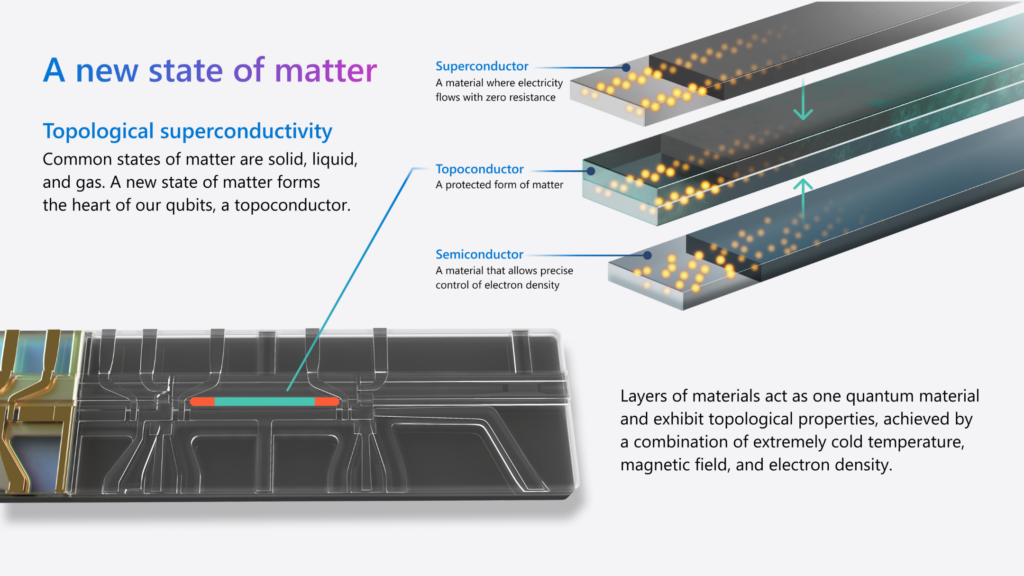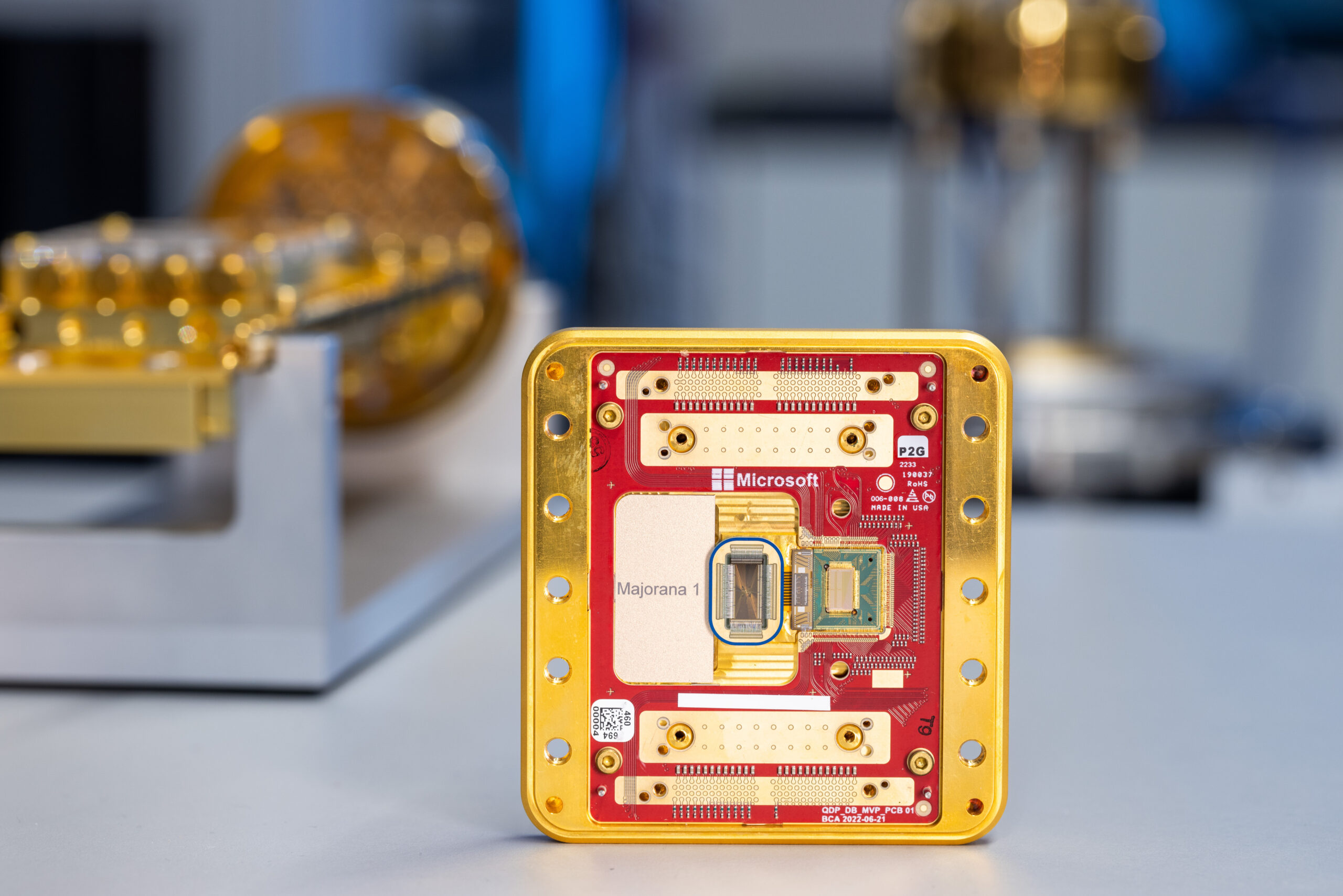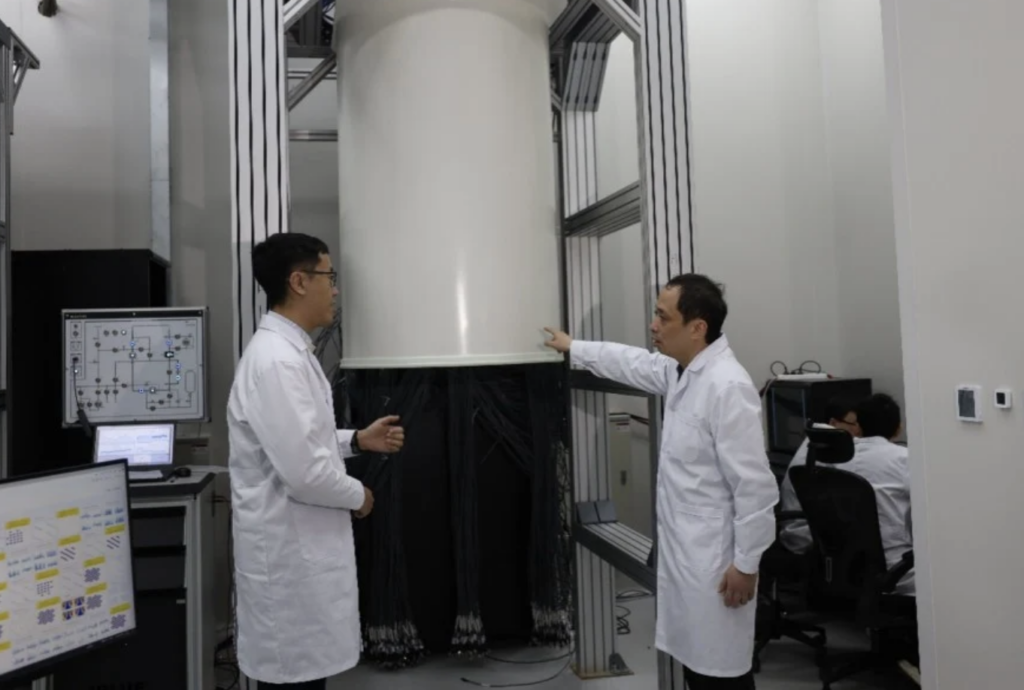Insider Brief
- Microsoft has made progress toward building a more stable quantum computer by successfully measuring a key property of exotic particles called Majorana zero modes.
- This experiment helps confirm an important step in Microsoft’s plan to create error-resistant quantum computers, though confirmation still awaits about whether the observed effects are truly from Majorana particles.
- The next challenge is scaling up this approach while solving issues like material imperfections and ensuring these quantum systems remain reliable in real-world conditions.
Microsoft has long pursued a unique path in quantum computing, focusing on topological qubits, which rely on Majorana zero modes (MZMs). Their latest research, detailed in a recent Nature paper, showcases a significant step forward: The company’s researchers are now reporting they implemented of a single-shot interferometric measurement of fermion parity in an indium arsenide-aluminum (InAs-Al) hybrid device.
To put it a little more simply, Microsoft successfully measured a fundamental quantum property in a special material using a precise one-time test. The team says this work supports the broader goal of achieving error-resistant quantum computation using topological states.
The fundamental motivation behind this approach is that these “topological quantum computers” could, in theory, offer inherent protection against many types of errors, making large-scale quantum systems more feasible.

But what exactly is happening in this new research, and what does it mean for the future of quantum computing?
We’ll try to unpack some of the key ideas in an accessible way.
What is a Majorana Zero Mode?
To understand Microsoft’s research, it’s essential to grasp the concept of Majorana zero modes, or MZMs. These are special types of quantum states that exist at the ends of certain superconducting wires. Unlike conventional particles, which have distinct matter and antimatter counterparts, Majorana particles are their own antiparticles.
In a quantum computer, information can be stored in the collective state of multiple MZMs, and operations can be performed by ‘braiding’ them—moving them around each other in a specific way. Theoretically, this process is resistant to many forms of noise and disturbance, making it an attractive foundation for quantum computation.

Microsoft’s Experiment: Measuring Fermion Parity
A crucial requirement for building a Majorana-based quantum computer is the ability to reliably measure the state of these particles. This is where Microsoft’s latest work comes in.
Their experiment — which might be a little like building a new state of matter sandwich — involves a device built from InAs-Al heterostructures—a combination of semiconductor (indium arsenide) and superconductor (aluminum). One of the key innovations in this setup is an interferometric setup that enables single-shot measurement of fermion parity.
Fermion parity is a fundamental property that indicates whether a system contains an even or odd number of electrons. In the context of MZMs, measuring parity allows researchers to confirm whether the system behaves as expected and provides a critical validation step toward using these states for computation.
The researchers accomplished this by coupling the superconducting nanowire to quantum dots — which are tiny semiconductor regions that can trap and manipulate electrons. These quantum dots serve as a readout mechanism, where shifts in their quantum capacitance signal changes in fermion parity. The experiment demonstrated that these shifts can be detected with a high signal-to-noise ratio, achieving a parity assignment error probability of just 1%.
So Why Does This Matter?
As alluded to above, quantum computing developers face of major challenges in the form of errors caused by the devices fragile nature of qubits. Error correction is a tool that tries to tame these errors. However, traditional approaches rely on complex error-correcting codes that require many physical qubits to create a single logical qubit. Microsoft’s strategy with topological qubits aims to bypass much of this overhead by leveraging the inherent stability of Majorana modes.
By demonstrating a reliable measurement technique for fermion parity, this research validates an essential ingredient for topological quantum computation. It brings Microsoft closer to realizing a fully functional Majorana-based qubit, which could dramatically simplify the development of large-scale quantum processors.
Limitations and Open Questions
One of the central debates in the field is whether the states observed in these experiments are truly Majorana zero modes or if they are actually Andreev bound states, which can mimic some of the same properties. Andreev bound states arise in superconducting materials and can form under certain conditions that make them difficult to distinguish from Majorana modes. The study acknowledges this ambiguity, indicating that further experimental and theoretical investigations are necessary to resolve this question definitively.
Beyond identifying true Majorana behavior, scaling this technology to a practical quantum computer will likely present additional challenges. The recent experiment demonstrated the ability to measure fermion parity in a single-shot process, but a full-fledged quantum processor will require integrating many such devices while ensuring they remain coherent and stable. Ensuring these qubits function reliably in a larger system will requre further work in materials, device fabrication, and error mitigation strategies.
Even if scalability is addressed, there is always the chance that real-world imperfections will create obstacles. Theoretically, topological qubits should be resilient to many types of noise. However, in practice, material defects, environmental disturbances, and quasiparticle poisoning can still degrade performance. These issues introduce error sources that could impact the viability of topological quantum computing if not effectively managed. Further research would quantify and mitigate these limitations to ensure that Majorana-based qubits can function as a stable and scalable foundation for quantum computation.
Where/How Does Microsoft Go From Here?
To move beyond these limitations, Microsoft has laid out a road map for achieving fault-tolerant quantum computation using Majorana-based qubits. The road map was described in a paper uploaded to the pre-print server arXiv.
According to the paper, the first step focuses on a single-qubit device designed to benchmark the performance of an isolated topological qubit. This phase is critical for understanding how reliably the quantum state can be measured and maintained, providing a foundation for the next stages of development.
Building on this, the second phase introduces a two-qubit device that enables measurement-based braiding operations. This demonstration is vital to confirming the non-Abelian nature of Majorana zero modes, a property that distinguishes them from conventional quantum states. Unlike traditional quantum gates that require precise control over qubit interactions, measurement-based braiding allows logical operations to be performed by simply controlling measurements, reducing susceptibility to errors.
Once these foundational steps are validated, the third phase expands to an eight-qubit device that incorporates quantum error detection mechanisms. This setup allows researchers to study how multiple qubits can work together to mitigate errors, a necessary precursor to fault-tolerant computation. Successfully demonstrating improved stability and error rates at this stage is a significant milestone in proving the feasibility of Majorana-based quantum computing.
The final phase of the roadmap envisions a scalable qubit array capable of performing lattice surgery, a key technique for large-scale quantum error correction. By linking multiple logical qubits in a stable network, this stage aims to establish a truly fault-tolerant quantum computing architecture. If successful, this approach could dramatically reduce the number of physical qubits required per logical qubit, making practical quantum computing more viable than ever before.
Each step in this roadmap builds systematically on the previous one, addressing the major hurdles of reliability, scalability, and error correction. The goal is to develop a quantum computing framework that offers a clear advantage over conventional qubit designs, paving the way for a robust and scalable quantum future.
A Re-cap
Microsoft’s latest Majorana-based quantum computing research marks a significant milestone for the company. It represents more than a scientific and technological advance, though. Most companies facing the steep challenge of topological computing and suffering the setbacks that will naturally come with it, would have likely given up on the research direction by now. The company indicates that Microsoft scientists have been exploring this line of research in quantum computing for 17 years.
With its significant monetary backing and amply talent surplus, Microsoft has persevered and this very well could be a pivot point not just in corporate history, but, also — forgive the rhetoric — in quantum history.
Microsoft’s achievement of high-fidelity, single-shot fermion parity measurement, future research could provide the scaffold for a new type of quantum computing architecture that could potentially overcome many of the challenges faced by conventional superconducting and trapped-ion qubits.
This is by no means a settled technology.
As covered, major questions remain, particularly regarding the unambiguous identification of Majorana zero modes and the feasibility of scaling up these devices. The coming years will determine whether Microsoft’s topological approach can compete with — and perhaps surpass — other leading quantum computing paradigms.
















